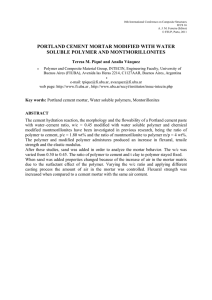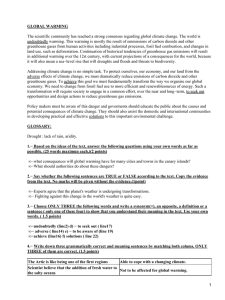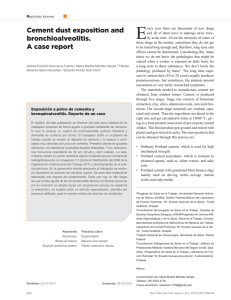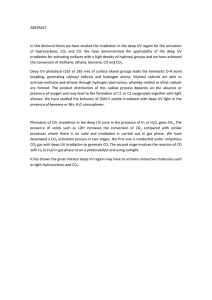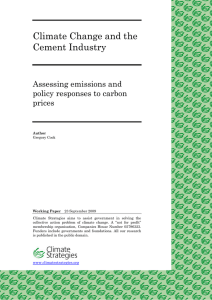The cement industry and climate change
Anuncio
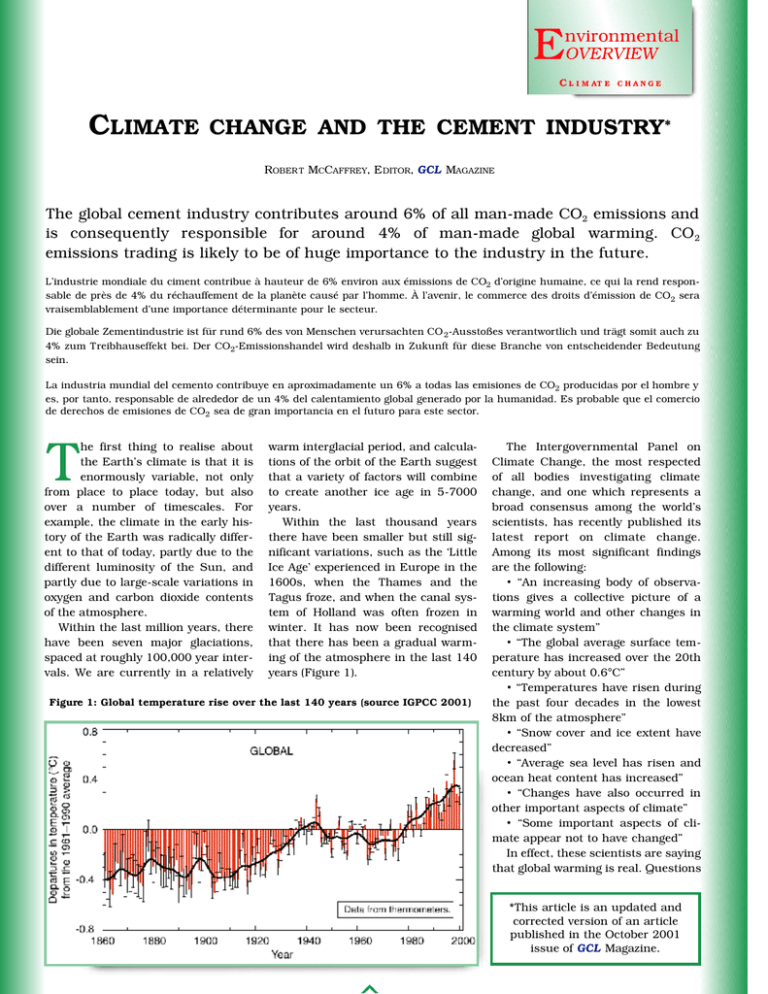
E nvironmental OVERVIEW C L I M AT E CLIMATE CHANGE CHANGE AND THE CEMENT INDUSTRY* ROBER T MCCAFFREY, E DITOR, GCL MAGAZINE The global cement industry contributes around 6% of all man-made CO2 emissions and is consequently responsible for around 4% of man-made global warming. CO2 emissions trading is likely to be of huge importance to the industry in the future. L’industrie mondiale du ciment contribue à hauteur de 6% environ aux émissions de CO2 d’origine humaine, ce qui la rend responsable de près de 4% du réchauffement de la planète causé par l’homme. À l’avenir, le commerce des droits d’émission de CO2 sera vraisemblablement d’une importance déterminante pour le secteur. Die globale Zementindustrie ist für rund 6% des von Menschen verursachten CO 2-Ausstoßes verantwortlich und trägt somit auch zu 4% zum Treibhauseffekt bei. Der CO2-Emissionshandel wird deshalb in Zukunft für diese Branche von entscheidender Bedeutung sein. La industria mundial del cemento contribuye en aproximadamente un 6% a todas las emisiones de CO2 producidas por el hombre y es, por tanto, responsable de alrededor de un 4% del calentamiento global generado por la humanidad. Es probable que el comercio de derechos de emisiones de CO2 sea de gran importancia en el futuro para este sector. T he first thing to realise about the Earth’s climate is that it is enormously variable, not only from place to place today, but also over a number of timescales. For example, the climate in the early history of the Earth was radically different to that of today, partly due to the different luminosity of the Sun, and partly due to large-scale variations in oxygen and carbon dioxide contents of the atmosphere. Within the last million years, there have been seven major glaciations, spaced at roughly 100,000 year intervals. We are currently in a relatively warm interglacial period, and calculations of the orbit of the Earth suggest that a variety of factors will combine to create another ice age in 5-7000 years. Within the last thousand years there have been smaller but still significant variations, such as the ‘Little Ice Age’ experienced in Europe in the 1600s, when the Thames and the Tagus froze, and when the canal system of Holland was often frozen in winter. It has now been recognised that there has been a gradual warming of the atmosphere in the last 140 years (Figure 1). Figure 1: Global temperature rise over the last 140 years (source IGPCC 2001) The Intergovernmental Panel on Climate Change, the most respected of all bodies investigating climate change, and one which represents a broad consensus among the world’s scientists, has recently published its latest report on climate change. Among its most significant findings are the following: • “An increasing body of observations gives a collective picture of a warming world and other changes in the climate system” • “The global average surface temperature has increased over the 20th century by about 0.6°C” • “Temperatures have risen during the past four decades in the lowest 8km of the atmosphere” • “Snow cover and ice extent have decreased” • “Average sea level has risen and ocean heat content has increased” • “Changes have also occurred in other important aspects of climate” • “Some important aspects of climate appear not to have changed” In effect, these scientists are saying that global warming is real. Questions *This article is an updated and corrected version of an article published in the October 2001 issue of GCL Magazine. GCL: ENVIRONMENTAL SPECIAL ISSUE 2002 we might usefully ask ourselves include, ‘Why is it happening?’ and ‘Is it anything to do with us (and in particular, is it anything to do with the global cement industry?).’ Climate change factors There are a variety of factors which influence climate on both long and short time scales. For example, volcanoes emit CO2, sulphur compounds and dust during eruptions. Sulphur and dust emitted during the eruptions tend to form aerosols which block solar radiation from reaching the Earth’s surface, and which therefore tend to produce a cooling effect. Carbon dioxide, however, is a socalled greenhouse gas. It tends to block radiation from the earth’s atmosphere, and therefore tends to produce a warming effect. Variations in the orbit of the earth, including its eccentricity, the precession of the Earth’s angle of rotation and variations in its angle of tilt, all have a role to play in determining the amount of solar energy which falls on a particular spot on the earth’s surface, as well as on the total amount of energy which is received by the Earth as a whole. In addition, variations in solar activity (such as that experienced during the regular 11-year sunspot cycle, as well as longer-term CLIMATE variations in total solar luminosity) will have an obvious effect on terrestrial climate systems. Changes in atmospheric composition can have a major effect on climate. This is where humanity may have a role to play in climate change. Man-made global warming Greenhouse warming arises from the release into the atmosphere of gases that absorb the infrared radiation emitted by the earth, thus preventing the escape of the radiation into space. Examples of greenhouse gases include CO2, CH4, NOx and HFCs. The fact is that humans have produced substantial quantities of these greenhouse gases, and the contribution of the cement industry has been substantial - and is likely to grow. Cement industry emissions The cement industry has four major emissions which have a cooling or heating effect on the Earth through an effect on radiative forcing - the change in net irradiance in Wm-2. These emissions are dust emissions, sulphur, NOx and CO 2. The contribution to global warming by the cement industry of the first three is not significant. For example, the total amount of natural dust produced each year in around 3Bt, whereas all *Calculating the cement industry’s role in man-made CO2 emissions and global warming The total global production of cement is derived from publications by Cembureau and from the Global Cement Report. The total depends on whether production from China's shaft kilns are included: this cement is included in the total here, since shaft kilns not only still produce CO2, but also burn their fuel less efficiently than rotary kilns. Around 970kg of CO2 is produced per tonne of clinker produced (see Marchal 2001). With 5% addition of gypsum, and widely varying amounts of substitution (but estimated at 5% average around the world), the amount of clinker in an 'average' tonne of cement produced is around 900kg. The figure for total man-made CO2, 6.3 ±0.4Bt of C (= 23.1Bt of CO2 ) production is taken from the IGPCC 2001 report (see bibliography). This calculation to find the cement industry's yearly current contribution to global man-made CO 2 emissions is as follows: Each tonne of normal clinker produced produces 970kg of CO2 . With around 900kg of clinker in a tonne of cement, each tonne of cement is associated with emissions of (0.97t CO 2 /t clinker x 0.9t clinker/t cement) = 0.873t CO2 Global cement production = 1.6Bt x 0.873t CO2 /t cement = 1.3968Bt CO2 1.3968Bt CO 2 (cement industry)/23.1Bt CO 2 (total man-made CO 2 ) = 6%. According to the IGPCC, CO2 is responsible for around 65% of man-made global warming, and the cement industry therefore seems to be responsible for around 4% of the total global warming effect. CHANGE AND THE CEMENT INDUSTRY industrial sources of dust total 100Mta. The global cement industry contributes a small proportion of this total. While dust is a significant local nuisance, the sight of a Saharan dust storm bearing down on a relatively clean cement plant perhaps puts the problem into perspective. Again, the sulphur emissions of the cement industry are not significant on a global scale. Nearly 100% of anthropogenic emissions of sulphur are from oil and coal combustion, and from copper production. In any case, sulphur is currently thought to play a role in global cooling, through the formation of aerosols (see above). The NOx emissions of the cement industry are again not significant on a global scale, but again may be a local nuisance. The larger part of global NOx emissions are from fossil fuel combustion, biomass burning and lightning strikes. Advanced technology, such as low-NOx burners, and specially-designed pyroprocessing lines, has a major part to play in the reduction of NOx emissions from the cement industry. However, in contrast to dust, sulphur and NOx emissions, CO2 emissions from the global cement industry are significant - and they are increasing. Global cement production is currently around 1.6Bt/y, and through the calcination of limestone to produce calcium oxide and carbon dioxide, approximately 0.97t of CO2 is produced for each tonne of clinker produced. Taking into account gypsum addition, and the use of substitutes such as limestone, and slag, I estimate that on average around 900kg of clinker is used in each 1000kg of cement produced. In this simple and presently unavoidable way, the global cement industry produces around 1.4Bt of CO2 each year. Total global manmade CO 2 production is around 23.1Bt now, so that the contribution of the global cement industry to worldwide man-made CO 2 production is about 6%.* We have to remember that not all gases are made equal. Different gases have dif ferent Global Wa rm i n g Potentials - CO2 has the lowest GWP (GWP = cumulative radiative forcing, GCL: ENVIRONMENTAL SPECIAL ISSUE 2002 CLIMATE CHANGE AND THE CEMENT INDUSTRY F i g u re 2 (Left): Global C O 2 concentrations to 2001, predicted by a variety of possible scenarios. Figure 3 (Right): Global temperature change predicted by a variety of possible scenarios, ranging f rom decreasing emissions, through business as usual to incr e a s e d emissions. Note that temperatures continue to rise in all scenarios. (Source: IGPCC). where radiative forcing is the change in net irradiance in Wm-2). So for example, a molecule of methane, CH4, would have 56 times more effect than a molecule of CO2 over a span of 20 years, while a molecule of HFC23, one of the banned hydrofluorocarbons, would have 9100 times more effect than CO 2. What is also important to remember, however, is that the total global production of CO2 runs into billions of tonnes. And remember also that CO2 is not just active as a greenhouse gas for a day or a week, but for decades and possibly centuries after its creation (Figures 2a, b & Figure 3). Production increasing Cement production increases at about 3%/year at the moment. This rate is set to increase as developing nations rapidly become richer, and spend proportionately more or cement-intensive infrastructure. The lowest projections suggest that by 2050, global per capita income will be more than 50% higher than in 1990, while similarly India’s per capita income will be more than 100% higher than in 1990, and Asia’s per capita income will be more than 500% higher than in 1990. These two countries alone account for more than one third of the world’s population. It is likely that the contribution of the cement industry to CO2 emissions is likely to keep pace with or overtake global population increases. Although the cement industry does not have a significant part to play in some factors influencing climate change - CH 4 escape from the oil and gas industries, NOx and Halocarbon production, and solar variability, it does have a notable contribution to CO2 production. The fraction of radiative forcing due to CO2 is projected to increase from about 50% in 2000 to about 75% in 2100. Since the cement industry produces around 6% of man-made CO2, and CO2 is responsible for 65% of radiative forcing, at the moment, the cement industry can be seen to be responsible for about 4% of all man-made global warming. It is likely that CO2 emissions will become more important to society at large and less acceptable. Global warming The latest report of the Intergovernmental Panel on Climate Change (the IGPCC) forecasts the following phenomena for the 21st century, as being ‘likely’ or ‘very likely.’ • Higher maximum temperatures and more hot days over nearly all land areas • Higher minimum temperatures, fewer cold days and frost days over nearly all land areas • Reduced diurnal temperature range over most land areas • More intense precipitation events • Increased summer continental drying and associated risk of drought over most mid-latitude continental interiors. • Increase in tropical cyclone peak wind intensities • Increase in tropical cyclone mean and peak precipitation intensities In other words, weather is set to become less predictable and potentially more destructive. Again, according to the IGPCC, emissions of CO2 due to fossil fuel burning (and to a lesser extent, due to cement production) are virtually certain to be the dominant influences on the trends in atmospheric CO2 concentration during the 21st century. Computer models indicate that a decreasing fraction of man-made CO2 emissions will be taken up by sea and land: so that there is likely to be an acceleration of CO2 content in the atmosphere. With this background of increasing atmospheric CO 2 content, reductions in greenhouse gas emissions will be necessary to stabilise radiative forcing (heating of the atmosphere). Carbon cycle models indicate that stabilisation of atmospheric CO 2 concentrations at 450ppm (compared to the 370ppm today) would require global man-made CO2 emissions to drop below 1990 levels within a few decades, and to continue to decrease steadily afterwards. To reduce human-led global warming and climate change, eventually CO2 emissions will need to decline to a very small fraction of current emissions. This is potentially bad news for today’s cement industry. Is there a solution? There is an old Chinese proverb, which states, “He that would have eggs must bear the cackling of hens.” If society wants cement-based roads, bridges, railways, skyscrapers, hospitals and modern homes, then cement production must continue. Calcination is the problem, since CaCO3 + heat = CaO + CO2. We cannot get around this fact - that conversion of limestone into clinker requires the evolution of CO2. However, there are alternatives to today’s greenhouse gas-producing cement. GCL: ENVIRONMENTAL SPECIAL ISSUE 2002 Alternatives For a start, it is possible to decrease the proportion of calcined material in cement. This is an attractive option for cement manufacturers, since calcined material is expensive, and substitutes are very often cheaper. Such lower cost and low or zero-greenhouse-gas emission substitutes include slag, fly ash, limestone and the use of proprietary fillers such as Slagstar or Cemstar. All of these reduce the amount of clinker used to produce a tonne of cement, and so reduce the amount of CO2 produced while producing a tonne of cement. For example, authors from Ecotrade have calculated that the total CO2 emission per tonne of OPC produced is 970kg, whereas for each tonne of ground granulated blast furnace slag produced, only 70kg of CO2 is produced. Substitution rates of over 33% are achievable (see Table 1). A second major step to decreasing the total amount of CO2 produced by the global cement industry would be to decrease the proportion of cement in concrete. This may be possible through the use of higher-strength cement, such as Vicon (Sobolev & Podmore 2001). This is a new type of cement produced with a siliceous admixture introduced during grinding, producing very high 1-day (44MPa) and 90-day (96MPa) strengths, allowing cement and concrete production with lower clinker content. Although reducing the amount of cement in concrete might not be popular among cement producers, it is possible that they would be able to charge a premium for such ‘super cement,’ which would allow them to recoup their losses on volumes. A third step towards decreasing the total amount of CO2 produced by the global cement industry would be to decrease the number of buildings CLIMATE using cement. Rammed earth, where soil is compressed within a formwork to create a concrete-like mass, has enjoyed a comeback in recent years, and has been employed in ‘modern’ buildings such as the visitor’s centre at the world-renowned Eden Project in Cornwall, UK. Additionally, novel non-calcined clay-based binders are under development in the US. Perhaps we should remember that around 60% of human habitation uses non-cement based technology, for example mud bricks and rammed earth. Sections of the Great Wall of China, which still exist today, were built with this technology. Other current applications for cement (bridges, dams etc) might also tend to look towards novel options in the future. Lafarge’s new Ductal cement-based material, which incorporates strengthening fibres, holds out the promise of very slender structures of great strength and low mass. A last option for an eventual decrease in CO2 emissions from the global cement industry might be a longer-term decrease in living standards for humans, and a global decrease in per-capita cement consumption. However, the old Chinese proverb “He who wants less is happier with what he gets” is more often quoted by those who have, than by those who have not. Other options for change Climate change is coming. Even if our emissions stabilised at 1990 levels by 2050, then man-made greenhouse gases (primarily CO 2) will continue to drive up temperatures until at least the end of the century. The ability of the human race to cope with change is a vital factor in our response to climate change. In general, the capability of the poor to cope with these changes is far lower than those of the rich: the burden of climate change Table 1: CO 2 emissions for OPC and blast furnace slag Calcination of CaCO 3 Fossil fuel (coal) Electricity generation CO2 emission/t OPC 540kg 340kg 90kg CO 2 emission/t GGBFS 0kg 20kg (drying) 50kg Total 970kg 70kg From ‘decreasing pollution,’ G. Marchal, C&BMR 3, 2001. CHANGE AND THE CEMENT INDUSTRY will fall disproportionately on those in the poor in Africa and Asia, as well on the world’s low-lying island nations. The resistance to change of the global cement industry will be a factor in future emission levels. Will the industry continue to produce more of today’s cement, leading to higher and higher total emissions? Or will the industry start to look seriously at lower or non-CO 2 producing options? There are obvious vested interests: a cement factory costing US$250m is not going to be closed a year after it has been built, just because it creates a small fraction of the total of man-made CO2. However, after 50 years of operation, its cost should have depreciated to almost zero, and in the meantime, cement companies might have invested in non-CO2 producing binders which add to their revenue and profits, and which can progressively replace cement as their main business. Options running out In any case, cement companies may not have the option of continuing to make cement in the long-term. Global CO2 emissions trading is likely to be instituted at some point in the future (by 2005 in Europe at least), with CO2 produced by cement manufacture ‘taxed’ just as highly as the same amount of CO 2 produced through the burning of fossil fuels. As a low added-value product, cement (unlike petrol, for example) may be unable to recoup its CO2 emission costs through very much higher prices. In this case, cement could become very expensive, and non-CO2 producing binders could become the inexpensive and preferred alternative. Imagine if you were a cement company faced with this scenario now. What would you do? Perhaps the first thing you should do is invest in some R&D to find the replacement for cement. Lafarge has set up a research department “with the mandate to identify and evaluate climate-friendly ideas and materials, however farfetched they may seem.” Taiheiyo’s production of Ecocement is a bold first step. Who will make the next move? GCL: ENVIRONMENTAL SPECIAL ISSUE 2002 Final thoughts Climate warming may have unpredictable effects. For example, warming over south American might lead to the drying out of the Rain Forest in Amazonia. With a dried-out forest, the burning of the Amazon Rain Forest could discharge as much as 150Bt of carbon into the atmosphere. This might have a knock-on effect on ocean warming and the stability of gas hydrates on the ocean floor, or it might accelerate the loss of carbon stored in per mafrost, accelerating greenhouse gas emissions and global warming. A chain reaction which rapidly warmed the planet is certainly possible. As mentioned at the start of this article, the planet is currently in an interglacial period. In about 5-7000 years, the planet is due to start cooling again, as the Earth’s orbital parameters again combine to reduce the amount of solar radiation reaching the surface of the planet. Temperatures are due to drop by around 5°C over the next 10,000 years due to these orbital variations. Should we be warming the atmosphere, possibly through the injection of 35Mt/y SO2 injection, as one Russian scientist has suggested, or CLIMATE through the introduction of smaller quantities of very potent greenhouse gases such as carbon tetrafluoride? As a very final thought though, we should remember that, in the long term, life on Earth is untenable due to an increase in solar radiance past one billion years time. At that point average surface temperatures will pass 100°C, all of the water on the planet’s surface will have boiled off into space, and all life on Earth man, fishes and bacteria alike - will be a distant memory. Bibliography 1. Atmosphere, climate and change. Thomas E. Graedel & Paul J. Crutszen, 1997 Scientific American Library, ISSN 140-3213-5026-0. 2. Atmosphere, weather and climate. Roger G. Barry & Richard J. Chorely, 7th edition 1998. Routledge, ISBN 0415 16019-7. 3. Climate change, William J. Burroughs, 2001. Cambridge University Press, ISBN 0-521-56771-8. 4. Intergovernmental Panel on Climate Change: Special report on Emissions 2001.http://www.grida.no/climate 5. Intergovernmental Panel on Climate Change: Summary for Policymakers, http://www.ipcc.ch/ CHANGE AND THE CEMENT INDUSTRY 6. Intergovernmental Panel on Climate Change: Technical Summary, http://www.ipcc.ch/ 7. Ozone and climate change, Stephen J. Reid, 2000. Gordon & Breach Science Publishers, ISBN 90-5699-233-3 (sc). Please note that there is a major error in this book - on page 158 it states “Every year, we release approximately seven billion tonnes of carbon dioxide into the atmosphere.” We actually release seven billion tonnes of carbon into the atmosphere each year, with the carbon dioxide equivalent being around 23 billion tonnes. 8. ‘Decreasing pollution,’ G. Marchal, Cement and Building Materials Review 3, 2001 (AUCBM). 9. ‘Vicon - the next big thing?’ Sobolev K & Podmore, C. GCL June 2001. 10. ‘Environmental technologies in the cement industry: towards zero emissions,’ Maekawa, H., Aoyama, O., Kagamida, M. Proceedings of the Asian Cement Conference 2001. 11. Building a sustainable world - a first report on our economic, social and environmental performance, 2001. Lafarge. 12. ‘Climate change and the cement industry’ McCaffrey, R. GCL October 2001. GCL’s Conference and forum London, Monday 27 May 2002 Market and economic trends influencing the global cement industry Full programme and further details available at www.propubs.com/gcl2002 It’s an uncertain world, and now more than ever you need to accurately assess the future possibilities affecting the global cement industry: what are the trends which will control the industry over the next five years?

